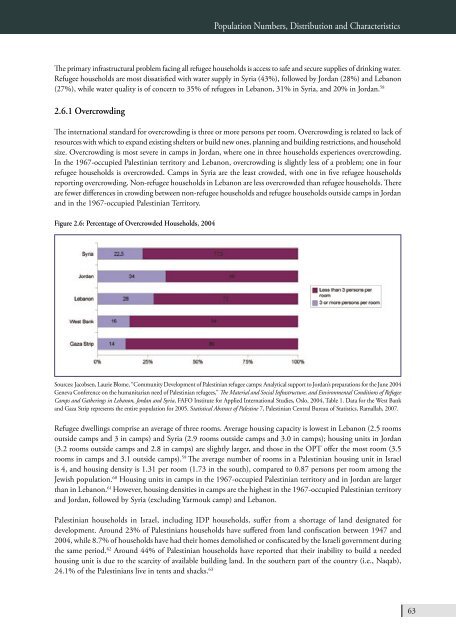BADIL Resource Center for Palestinian Residency and Refugee
BADIL Resource Center for Palestinian Residency and Refugee
BADIL Resource Center for Palestinian Residency and Refugee
You also want an ePaper? Increase the reach of your titles
YUMPU automatically turns print PDFs into web optimized ePapers that Google loves.
Population Numbers, Distribution <strong>and</strong> Characteristics<br />
The primary infrastructural problem facing all refugee households is access to safe <strong>and</strong> secure supplies of drinking water.<br />
<strong>Refugee</strong> households are most dissatisfied with water supply in Syria (43%), followed by Jordan (28%) <strong>and</strong> Lebanon<br />
(27%), while water quality is of concern to 35% of refugees in Lebanon, 31% in Syria, <strong>and</strong> 20% in Jordan. 58<br />
2.6.1 Overcrowding<br />
The international st<strong>and</strong>ard <strong>for</strong> overcrowding is three or more persons per room. Overcrowding is related to lack of<br />
resources with which to exp<strong>and</strong> existing shelters or build new ones, planning <strong>and</strong> building restrictions, <strong>and</strong> household<br />
size. Overcrowding is most severe in camps in Jordan, where one in three households experiences overcrowding.<br />
In the 1967-occupied <strong>Palestinian</strong> territory <strong>and</strong> Lebanon, overcrowding is slightly less of a problem; one in four<br />
refugee households is overcrowded. Camps in Syria are the least crowded, with one in five refugee households<br />
reporting overcrowding. Non-refugee households in Lebanon are less overcrowded than refugee households. There<br />
are fewer differences in crowding between non-refugee households <strong>and</strong> refugee households outside camps in Jordan<br />
<strong>and</strong> in the 1967-occupied <strong>Palestinian</strong> Territory.<br />
Figure 2.6: Percentage of Overcrowded Households, 2004<br />
Sources: Jacobsen, Laurie Blome, “Community Development of <strong>Palestinian</strong> refugee camps: Analytical support to Jordan’s preparations <strong>for</strong> the June 2004<br />
Geneva Conference on the humanitarian need of <strong>Palestinian</strong> refugees,” The Material <strong>and</strong> Social Infrastructure, <strong>and</strong> Environmental Conditions of <strong>Refugee</strong><br />
Camps <strong>and</strong> Gatherings in Lebanon, Jordan <strong>and</strong> Syria, FAFO Institute <strong>for</strong> Applied International Studies, Oslo, 2004, Table 1. Data <strong>for</strong> the West Bank<br />
<strong>and</strong> Gaza Strip represents the entire population <strong>for</strong> 2005. Statistical Abstract of Palestine 7, <strong>Palestinian</strong> Central Bureau of Statistics, Ramallah, 2007.<br />
<strong>Refugee</strong> dwellings comprise an average of three rooms. Average housing capacity is lowest in Lebanon (2.5 rooms<br />
outside camps <strong>and</strong> 3 in camps) <strong>and</strong> Syria (2.9 rooms outside camps <strong>and</strong> 3.0 in camps); housing units in Jordan<br />
(3.2 rooms outside camps <strong>and</strong> 2.8 in camps) are slightly larger, <strong>and</strong> those in the OPT offer the most room (3.5<br />
rooms in camps <strong>and</strong> 3.1 outside camps). 59 The average number of rooms in a <strong>Palestinian</strong> housing unit in Israel<br />
is 4, <strong>and</strong> housing density is 1.31 per room (1.73 in the south), compared to 0.87 persons per room among the<br />
Jewish population. 60 Housing units in camps in the 1967-occupied <strong>Palestinian</strong> territory <strong>and</strong> in Jordan are larger<br />
than in Lebanon. 61 However, housing densities in camps are the highest in the 1967-occupied <strong>Palestinian</strong> territory<br />
<strong>and</strong> Jordan, followed by Syria (excluding Yarmouk camp) <strong>and</strong> Lebanon.<br />
<strong>Palestinian</strong> households in Israel, including IDP households, suffer from a shortage of l<strong>and</strong> designated <strong>for</strong><br />
development. Around 23% of <strong>Palestinian</strong>s households have suffered from l<strong>and</strong> confiscation between 1947 <strong>and</strong><br />
2004, while 8.7% of households have had their homes demolished or confiscated by the Israeli government during<br />
the same period. 62 Around 44% of <strong>Palestinian</strong> households have reported that their inability to build a needed<br />
housing unit is due to the scarcity of available building l<strong>and</strong>. In the southern part of the country (i.e., Naqab),<br />
24.1% of the <strong>Palestinian</strong>s live in tents <strong>and</strong> shacks. 63<br />
63

















